
The best annual climbing plants to quickly beautify your garden
Floriferous varieties that grow quickly and are easy to cultivate
Contents
If annual plants have lost some of their popularity in recent years, in favour of more long-lasting perennials, they remain essential and should not be overlooked. Offering us a great variety of cultivars, they come in all tastes and styles for every garden.
The climbing annuals are among the most generous, aesthetic and fast-growing plants, perfect for simply dressing up a structure throughout the beautiful season. To adorn your garden, terrace or balcony, discover these annuals, along with our tips for choosing them well.
The Benefits of Annual Plants in the Garden
If we recommend turning to annual plants in the garden, it’s because they offer multiple advantages.
- They fit everywhere, whether in small spaces or large gardens, in containers or XXL flower beds. They are also perfect candidates for filling gaps and providing a quick visual impact.
- Their great diversity caters to all tastes, with flowerings that can be delicate, refined, rustic, sophisticated, etc.
- They flower generously for long weeks, almost from late spring until the first frosts for most of them. This is due to their very short life cycle (just one year), which drives them to be as productive as possible to ensure the survival of the species.
- They possess many ornamental qualities: flowering, of course, but also foliage, habit, and even fruiting and fragrance.
- Annuals are perfect for beginner gardeners or introducing children to the joys of gardening. They are very easy to sow and generally require little care.
- They allow you to change the scenery every year. If you grow tired of one, no problem—it will complete its cycle by the end of the year.
- However, many of them also have the ability to self-seed spontaneously and return year after year without intervention, if you let them do their thing.
- They are inexpensive to buy. Whether as seeds, plug plants or in buckets, they are more affordable than perennials or bushes. If you harvest your own seeds at the end of the season, you can even multiply them for free.
- Many annual flowers promote biodiversity by attracting a host of pollinating insects.
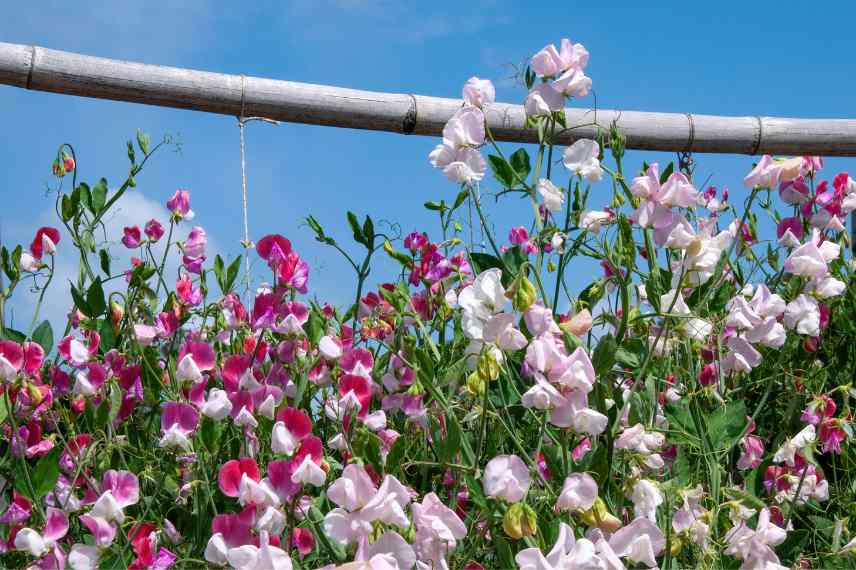
Sweet peas allow you to collect seeds from one year to the next
Why grow climbing annual plants?
Annual climbing plants are certainly among the fastest-growing plants. As we’ve seen, with their short life cycle, they only have a few months to reach ripeness. Climbers are therefore capable of growing several metres in record time. A boon for quickly covering an unsightly structure! But they also represent a clever solution for creating a beautiful living screen during the fine season. This allows you to enjoy the light in winter while being sheltered from prying eyes during the summer months.
Whether on a pergola, trellis, arch or balustrade, they’ll quickly create a lush, floriferous display. Generally, they will use their voluble stems to climb vertically, so won’t even need tying up as they grow. And if there’s no support to cling to, no problem: they can also make excellent ground cover or cascade beautifully from hanging baskets.
Climbing plants have the added advantage of taking up very little ground space. They can therefore fit even into compact gardens, playing with height to create an illusion of greater space.
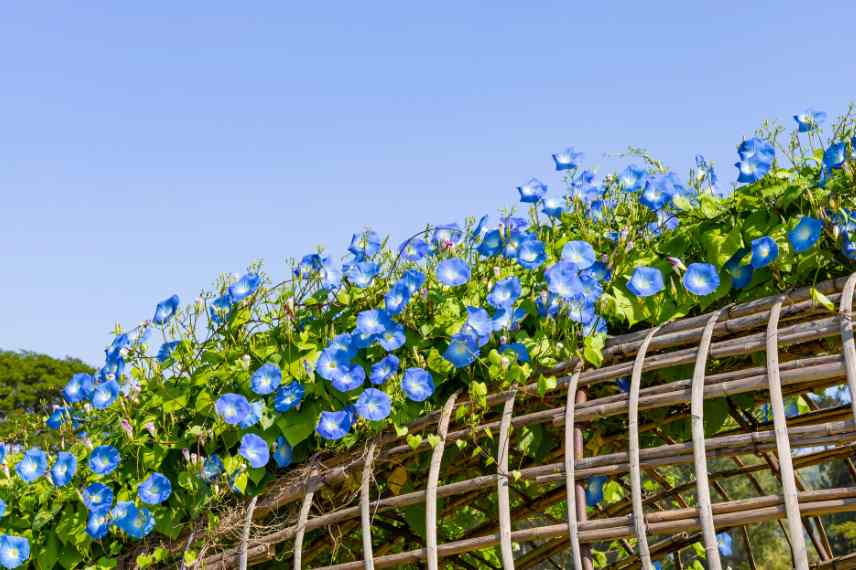
The charm of annual climbing plants lasts all summer!
How to choose the right climbing annuals?
To ensure you make the right choice regarding annual climbing plants, first consider your growing constraints. Each plant has its own requirements, and logically, not all will be suited to your garden.
You’ll need to determine:
- the type of soil (poor or rich in organic matter, clay or sandy, alkaline or acidic…);
- soil moisture (dry, moist or waterlogged);
- climate conditions (late frosts, intense summer heat, high rainfall, frequent droughts, sea spray, strong winds, etc.);
- exposure (sunny, dappled shade, partial shade, dark);
- available space (in pots or in the ground, small or large).
To help with this, discover our Plantfit application, which creates a specific profile of your garden and advises on which plants are or aren’t suitable.
Next, you’ll naturally choose annual climbers based on your preferences. Flower colours, shapes, silhouette, foliage, fruiting, fragrance… you’ll be spoilt for choice to create a display you love and that reflects your personality. And don’t forget that one advantage of annuals is that you can experiment and change the display the following year!
Some flowerings lend themselves better to a natural, rustic display, others have a more exotic style, while some bring welcome sophistication to a romantic-style garden, etc.
Annual climbers can perfectly complement perennial ground cover plants, ornamental grasses, or even help fill out an ageing rose bush or tree.
Note that some climbers are perennial plants in their native habitat. But being frost-tender, they’re grown as annuals in our climate. Nothing stops you from bringing them under frost protection in winter if you wish to keep them longer though.
Our favourite climbing annuals
Black-eyed Susan
The Black-eyed Susans, or Thunbergia alata, are among the most popular climbing annuals. In just a few weeks, they can cover any support provided. Generous, they flower abundantly from June to October, offering single flowers in often vibrant tones that contrast beautifully with their famous black eye which gives them their name.
These annuals are perfect for adding an exotic touch. The type species boasts a bright yellow hue, but several varieties exist. ‘Tangerine Slice’, for example, displays an uncommon bicoloured red and yellow tone, while ‘Sunny Suzy Cherry’ offers a stunning cherry red.
This climbing plant thrives in sun or partial shade, in fertile, well-drained soil (rich in organic matter but light enough to prevent water from stagnating around the roots). Choose a sheltered spot protected from winds.
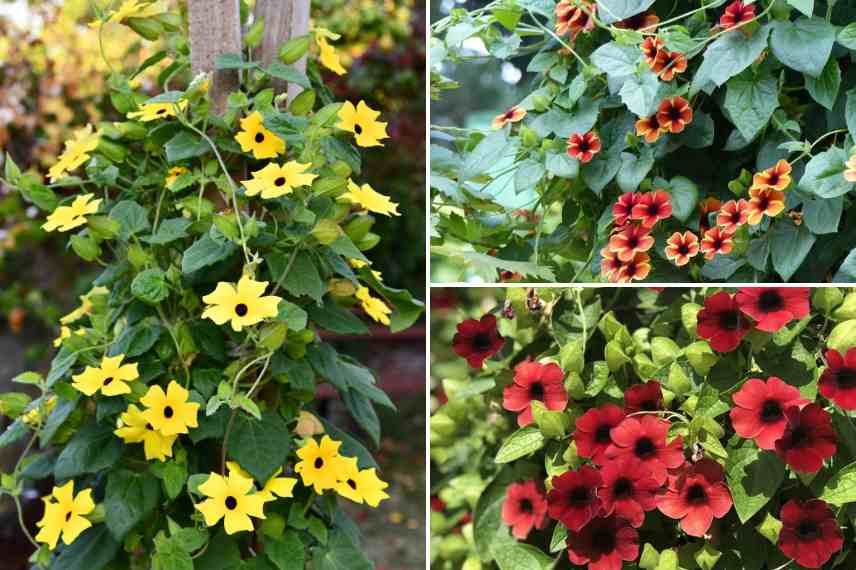
On the left, the type species, and on the right ‘Tangerine Slice’ and ‘Suny Suzy Cherry’
Nasturtium
The nasturtium (Tropaeolum majus) has everything to please. Its flowering first, generous and constantly renewed, consists of brightly coloured funnel-shaped flowers. With exotic charm, they bring joy and dynamism to both containers and gardens. But that’s not all: the foliage is also highly ornamental, made up of round leaves resembling miniature water lilies.
And to top it off, this climbing annual also finds its place in the kitchen. Leaves, flower buds and flowers are edible, perfect for adding peppery notes to salads.
Fall for the yellow varieties speckled with orange (‘Baby Orange’), double-flowered (‘Red Wonder’) or mixed varieties (‘Jewel of Africa’).
Nasturtiums thrive in sandy soil, even poor and dry, in warm and sunny locations.
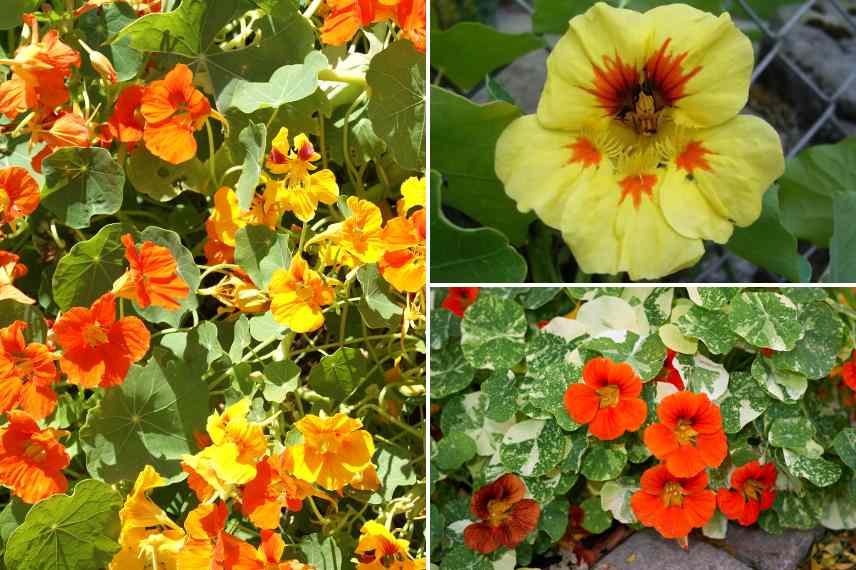
In shades of orange ranging from light to dark and with sometimes variegated foliage, nasturtiums remain classics among climbing annuals (top right, the variety ‘Baby Orange -Banana Split’)
Morning Glory
Other must-haves when discussing climbing annuals: the morning glories or Volubilis! They are characterised by their trumpet-shaped flowers which enliven the space for many weeks. They will cling to any nearby support thanks to their voluble stems. Here again, they are perfect plants for adding a touch of colour and exoticism.
Choose, for example:
- ‘Heavenly Blue’, which displays a beautiful azure blue;
- ‘Flying Saucer’, with its white trumpets striped with blue;
- ‘Grandpa Ott’, with intense purple-blue flowering;
- ‘La Vie en Rose’, which unsurprisingly blends several shades of pink, from the lightest to the most vibrant;
- the striking ‘Star of Yelta’, in an exceptionally deep violet-blue.
Note that the heart-shaped foliage is also very aesthetic and lush.
Morning glories can be grown effortlessly in pots or in the ground. They prefer fertile, light soil in sunny positions.
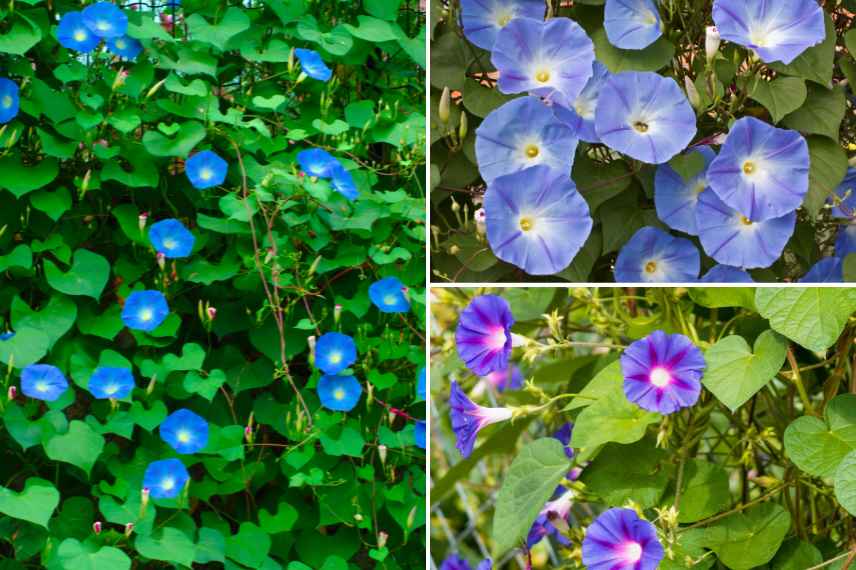
Morning glories display nuanced blues depending on the variety: top right, ‘Heavenly Blue’
Sweet Pea
One of the main assets of sweet peas is their fragrance. This climbing annual indeed offers a wide variety of colours and flower sizes, often highly fragrant. With growth as rapid as their counterparts, they easily climb any available support, twining with their flexible stems.
Enjoy their papilionaceous flowers from late spring to autumn. Among the varieties we love, let’s mention ‘Prince of Orange’ (orange and pink flowering), ‘Blue Ripple’ (light blue and white flowering), ‘Beaujolais’ (garnet red flowering) and ‘Spencer Old Times’ (highly fragrant cream-white flowering).
Grow in rich, deep soil that remains moist, in bright positions. For successful cultivation, consult our guide Growing Sweet Peas, from sowing to care.
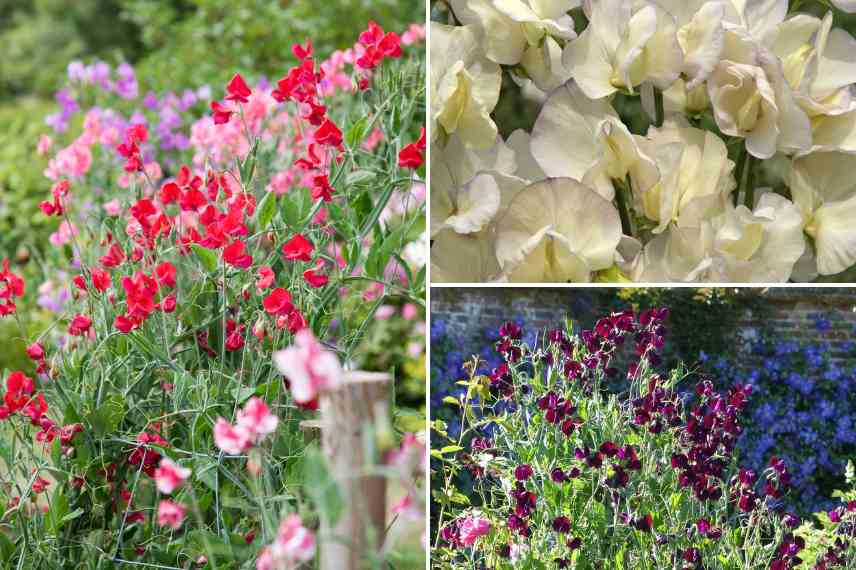
Sweet peas, essential in the English garden! On the right, the varieties ‘Spencer Old Times’ and ‘Beaujolais’
Other Highly Ornamental Climbing Annuals
This list of climbing annuals with multiple assets is not exhaustive. You can also choose:
- the runner bean, as beautiful as it is tasty;
- the Mina lobata, with its astonishing tubular flowering;
- the cobaea, vigorous and lush climbers with bell-shaped flowers;
- the small-fruited gourds, very original for their colourful and varied fruiting in the form of small squashes (non-edible), which can be kept for a long time.
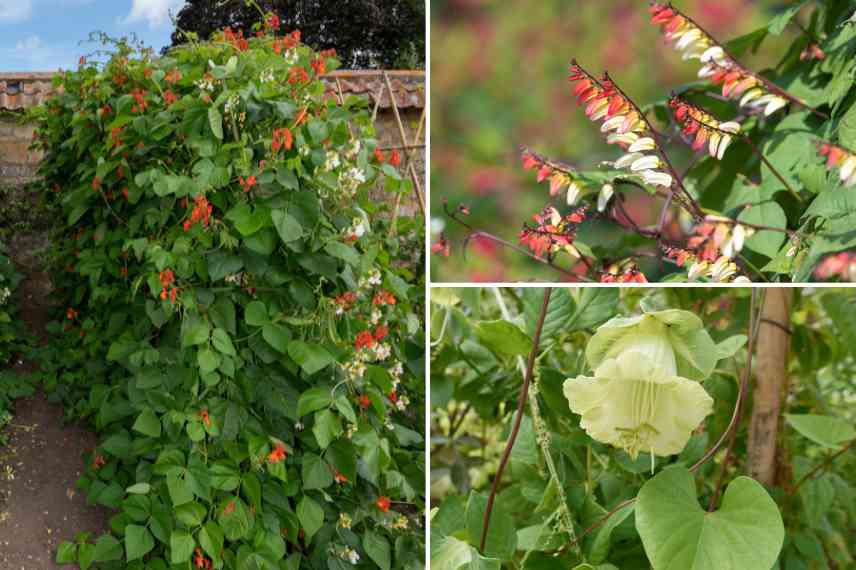
Runner bean, Mina lobata and Cobea scandes ‘Alba’
- Subscribe!
- Contents
































Comments